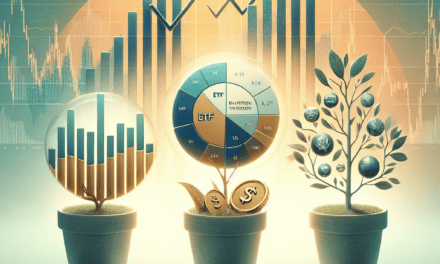“Rising Dollar: Market Braces for CPI Impact and Rate Adjustments”
Introduction
The US dollar experienced an upward trajectory in anticipation of the upcoming Consumer Price Index (CPI) report, as market participants adjusted their expectations regarding future interest rate movements. This development comes amid heightened scrutiny of inflationary pressures and their potential impact on the Federal Reserve’s monetary policy decisions. Investors are closely monitoring the CPI data, which is expected to provide critical insights into the pace of inflation and guide the Fed’s approach to interest rates. The dollar’s rise reflects a broader market sentiment that anticipates a possible recalibration of rate expectations, influencing currency valuations and financial markets globally.
Impact Of Rising Dollar On Global Markets
The recent ascent of the US dollar, particularly in anticipation of the Consumer Price Index (CPI) release, has sparked significant interest and concern across global markets. As investors adjust their expectations regarding the Federal Reserve’s monetary policy, the ripple effects of a stronger dollar are being felt worldwide. This development is not only reshaping currency dynamics but also influencing trade balances, commodity prices, and economic growth prospects in various regions.
To begin with, the appreciation of the dollar often leads to a depreciation of other currencies, particularly those of emerging markets. This shift can exacerbate existing economic vulnerabilities in these regions, as a weaker local currency makes it more expensive to service dollar-denominated debt. Consequently, countries with substantial foreign debt may face increased financial strain, potentially leading to tighter fiscal policies and reduced public spending. Moreover, a stronger dollar can also lead to capital outflows from emerging markets, as investors seek higher returns in US assets, further destabilizing these economies.
In addition to its impact on emerging markets, the rising dollar also affects global trade dynamics. A stronger dollar makes US exports more expensive and less competitive on the international stage, potentially leading to a decline in export volumes. Conversely, imports into the United States become cheaper, which could widen the US trade deficit. This shift in trade balances can have far-reaching implications for global supply chains and economic growth, as countries that rely heavily on exports to the US may experience reduced demand for their goods and services.
Furthermore, the dollar’s strength has a pronounced effect on commodity prices, given that many commodities are priced in US dollars. As the dollar appreciates, commodities become more expensive for buyers using other currencies, which can lead to decreased demand and downward pressure on prices. This trend is particularly evident in the oil market, where a stronger dollar can contribute to lower oil prices, impacting oil-exporting countries’ revenues and economic stability. Similarly, other commodities such as gold and agricultural products may also see price fluctuations, affecting producers and consumers worldwide.
In the context of adjusted rate expectations, the Federal Reserve’s monetary policy plays a crucial role in shaping the dollar’s trajectory. As investors anticipate potential interest rate hikes to combat inflation, the dollar’s appeal as a safe-haven asset increases. Higher interest rates typically attract foreign investment, as they offer better returns compared to other currencies with lower rates. This influx of capital can further bolster the dollar’s value, perpetuating its upward trend.
However, it is essential to consider the broader implications of a rising dollar on global economic growth. While a stronger dollar may benefit US consumers through cheaper imports and lower inflationary pressures, it can also pose challenges for multinational corporations with significant overseas operations. These companies may face reduced profits when converting foreign earnings back into dollars, potentially impacting their financial performance and stock valuations.
In conclusion, the rising dollar ahead of the US CPI release and amid adjusted rate expectations is a multifaceted phenomenon with wide-ranging effects on global markets. From influencing currency valuations and trade balances to affecting commodity prices and economic growth prospects, the dollar’s strength is a critical factor in the current economic landscape. As market participants continue to navigate these complexities, the interplay between monetary policy, currency dynamics, and global economic conditions will remain a focal point of attention.
US CPI Expectations And Their Influence On Currency Trends
The anticipation surrounding the release of the United States Consumer Price Index (CPI) has once again captured the attention of global financial markets, with the dollar experiencing a notable rise as investors adjust their expectations regarding future interest rate movements. The CPI, a critical indicator of inflation, plays a pivotal role in shaping monetary policy decisions by the Federal Reserve. As such, its influence extends beyond domestic borders, impacting currency trends worldwide.
In recent weeks, market participants have been closely monitoring economic data to gauge the trajectory of inflation and its potential implications for interest rates. The dollar’s ascent can be attributed to a recalibration of expectations, as investors increasingly speculate that the Federal Reserve may adopt a more hawkish stance in response to persistent inflationary pressures. This shift in sentiment has been fueled by a series of robust economic indicators, including strong employment figures and resilient consumer spending, which suggest that the US economy remains on a solid footing.
Moreover, the global economic landscape has been characterized by a divergence in monetary policy approaches among major central banks. While the Federal Reserve has signaled its readiness to tighten monetary policy if inflation remains elevated, other central banks, such as the European Central Bank and the Bank of Japan, have maintained a more accommodative stance. This divergence has further bolstered the dollar, as investors seek higher yields in the US relative to other regions.
The interplay between inflation expectations and currency trends is complex, with several factors contributing to the dollar’s recent strength. One key element is the market’s perception of the Federal Reserve’s credibility in managing inflation. As inflationary pressures persist, the central bank’s commitment to its dual mandate of price stability and maximum employment is being closely scrutinized. A credible commitment to curbing inflation can enhance investor confidence, thereby supporting the dollar.
Additionally, geopolitical developments and global risk sentiment have also played a role in shaping currency trends. In times of uncertainty, the dollar often serves as a safe-haven asset, attracting capital flows from investors seeking refuge from volatility. Recent geopolitical tensions and concerns over global economic growth have reinforced this dynamic, further underpinning the dollar’s appeal.
As the release of the US CPI approaches, market participants are keenly aware of the potential for volatility. A higher-than-expected CPI reading could reinforce expectations of a more aggressive tightening cycle by the Federal Reserve, potentially propelling the dollar even higher. Conversely, a softer inflation print might temper rate hike expectations, leading to a reassessment of currency positions.
In conclusion, the interplay between US CPI expectations and currency trends underscores the intricate relationship between economic indicators and market dynamics. As investors navigate this complex landscape, the dollar’s trajectory will continue to be influenced by a myriad of factors, including inflation data, monetary policy signals, and global risk sentiment. Ultimately, the evolving narrative surrounding inflation and interest rates will remain a focal point for market participants, shaping currency trends in the months ahead. As such, staying attuned to these developments will be crucial for investors seeking to navigate the ever-changing financial landscape.
Adjusted Rate Expectations: What Investors Need To Know
As the financial markets brace for the release of the U.S. Consumer Price Index (CPI) data, the dollar has experienced a notable rise, reflecting adjusted rate expectations among investors. This development underscores the intricate relationship between inflation indicators and monetary policy, which continues to shape market dynamics. Understanding these adjustments is crucial for investors seeking to navigate the complexities of the current economic landscape.
The anticipation surrounding the CPI data is rooted in its role as a key indicator of inflationary pressures within the economy. Inflation, in turn, influences the Federal Reserve’s monetary policy decisions, particularly regarding interest rates. As inflation rises, the central bank may opt to increase interest rates to curb excessive price growth, thereby impacting borrowing costs and economic activity. Consequently, investors closely monitor CPI figures to gauge potential shifts in monetary policy.
In recent months, inflation has been a focal point for both policymakers and market participants. The persistent rise in consumer prices has prompted the Federal Reserve to adopt a more hawkish stance, signaling potential rate hikes to address inflationary concerns. This shift in policy expectations has contributed to the strengthening of the dollar, as higher interest rates typically attract foreign investment, increasing demand for the currency.
Moreover, the dollar’s rise can be attributed to a recalibration of market expectations regarding the pace and magnitude of future rate adjustments. Investors are increasingly factoring in the possibility of more aggressive rate hikes, driven by the belief that the Federal Reserve will prioritize inflation control over economic growth. This recalibration has led to a reassessment of asset valuations, with the dollar emerging as a preferred safe-haven currency amid heightened uncertainty.
The interplay between inflation data and rate expectations is further complicated by global economic conditions. Supply chain disruptions, geopolitical tensions, and varying recovery trajectories across regions have all contributed to inflationary pressures, adding layers of complexity to the Federal Reserve’s decision-making process. As a result, investors must remain vigilant, considering both domestic and international factors when evaluating potential market movements.
In this context, it is essential for investors to adopt a comprehensive approach to market analysis. This involves not only monitoring inflation indicators but also assessing broader economic trends and geopolitical developments. By doing so, investors can better anticipate potential shifts in monetary policy and adjust their portfolios accordingly.
Furthermore, diversification remains a key strategy for managing risk in an environment characterized by uncertainty and volatility. By spreading investments across different asset classes and geographic regions, investors can mitigate the impact of adverse market movements and enhance their potential for long-term returns.
In conclusion, the rise of the dollar ahead of the U.S. CPI release highlights the significance of adjusted rate expectations in shaping market dynamics. As investors navigate this complex landscape, a thorough understanding of inflation indicators, monetary policy, and global economic conditions is essential. By staying informed and adopting a diversified investment approach, investors can better position themselves to capitalize on opportunities and manage risks in an ever-evolving financial environment.
Analyzing The Correlation Between US CPI And Dollar Strength
The relationship between the US Consumer Price Index (CPI) and the strength of the dollar is a subject of considerable interest to economists and investors alike. As the dollar rises ahead of the latest US CPI release, it is crucial to understand the underlying dynamics that drive this correlation. The CPI, a key indicator of inflation, reflects the average change over time in the prices paid by urban consumers for a market basket of consumer goods and services. When the CPI indicates rising inflation, it often prompts the Federal Reserve to adjust interest rates, which in turn influences the strength of the dollar.
In anticipation of the CPI data, market participants frequently adjust their expectations regarding future monetary policy. A higher-than-expected CPI reading can lead to speculation that the Federal Reserve will raise interest rates to curb inflation. Such expectations tend to bolster the dollar, as higher interest rates offer better returns on investments denominated in the currency. Consequently, investors flock to the dollar, driving up its value relative to other currencies. This preemptive adjustment in market behavior underscores the anticipatory nature of financial markets, where expectations often precede actual policy changes.
Moreover, the interplay between inflation data and currency strength is not solely confined to interest rate expectations. Inflation can also impact the purchasing power of a currency. When inflation is high, the real value of a currency diminishes, eroding its purchasing power. However, if the central bank is perceived as being proactive in combating inflation through monetary tightening, confidence in the currency can be restored, leading to a strengthening of the dollar. This complex relationship highlights the dual role of inflation data in influencing both market sentiment and economic fundamentals.
Furthermore, the global context cannot be overlooked when analyzing the correlation between US CPI and dollar strength. The dollar’s status as the world’s primary reserve currency means that its movements have far-reaching implications. A stronger dollar can affect global trade dynamics, making US exports more expensive and imports cheaper. This shift can influence trade balances and economic growth, both domestically and internationally. As such, the anticipation of US CPI data and its impact on the dollar is not only a domestic concern but also a global one.
In addition to these economic factors, geopolitical events and market sentiment also play a role in shaping the dollar’s trajectory. For instance, during times of geopolitical uncertainty, investors often seek safe-haven assets, with the dollar being a preferred choice. This flight to safety can amplify the dollar’s strength, independent of domestic inflation data. Therefore, while the US CPI is a critical factor, it is part of a broader tapestry of influences that determine the dollar’s value.
In conclusion, the rise of the dollar ahead of the US CPI release is a multifaceted phenomenon driven by adjusted rate expectations, inflation dynamics, and global economic considerations. Understanding this correlation requires a nuanced appreciation of how inflation data influences monetary policy, market sentiment, and international trade. As investors and policymakers await the latest CPI figures, the intricate dance between inflation and currency strength continues to captivate and challenge those seeking to navigate the complexities of the global financial landscape.
Market Reactions To Shifts In US Monetary Policy
The financial markets have been closely monitoring the movements of the US dollar, particularly as it rises ahead of the Consumer Price Index (CPI) release. This ascent is largely attributed to adjusted expectations regarding the Federal Reserve’s monetary policy. As investors anticipate the CPI data, which serves as a critical indicator of inflation, the dollar’s strength reflects a broader market sentiment that is increasingly attuned to potential shifts in interest rates. The anticipation of the CPI report has led to heightened speculation about the Federal Reserve’s next moves, with many market participants recalibrating their expectations for future rate hikes.
In recent months, the Federal Reserve has been navigating a complex economic landscape, characterized by persistent inflationary pressures and a labor market that remains robust. As a result, the central bank has been under scrutiny, with its policy decisions having far-reaching implications for both domestic and global markets. The dollar’s rise is indicative of a market that is pricing in the possibility of more aggressive monetary tightening, should the CPI data reveal higher-than-expected inflation. This scenario underscores the delicate balance the Federal Reserve must maintain between curbing inflation and supporting economic growth.
Moreover, the dollar’s appreciation has significant ramifications for various asset classes. For instance, a stronger dollar typically exerts downward pressure on commodities priced in the currency, such as oil and gold, as it makes them more expensive for holders of other currencies. Consequently, investors in these markets are also closely watching the CPI figures, as they could influence commodity prices and, by extension, the broader economic outlook. Additionally, the dollar’s strength can impact multinational corporations, particularly those with substantial overseas revenues, as currency fluctuations can affect their earnings.
Transitioning to the bond market, the anticipation of the CPI report has also led to fluctuations in Treasury yields. As investors adjust their portfolios in response to potential changes in interest rates, yields have experienced volatility. A higher-than-expected CPI reading could prompt a sell-off in bonds, driving yields up as investors demand higher returns to compensate for anticipated inflation. Conversely, a lower-than-expected figure might lead to a rally in bonds, as it could signal a more dovish stance from the Federal Reserve.
In the equity markets, the dollar’s rise and the looming CPI data have created a mixed environment. On one hand, sectors that benefit from higher interest rates, such as financials, may see gains. On the other hand, growth-oriented sectors, particularly technology, could face headwinds as higher rates increase borrowing costs and discount future earnings. This dynamic highlights the interconnectedness of financial markets and the ripple effects that monetary policy expectations can have across different sectors.
In conclusion, the dollar’s rise ahead of the US CPI release is a reflection of market participants’ recalibrated expectations regarding Federal Reserve policy. As investors brace for the inflation data, the potential implications for interest rates are being carefully weighed across various asset classes. The outcome of the CPI report will likely provide further clarity on the central bank’s path forward, influencing market reactions and shaping the economic landscape in the months to come. As such, the interplay between inflation data, monetary policy, and market movements remains a focal point for investors navigating these uncertain times.
The Role Of Inflation Data In Currency Valuation
In the intricate world of currency valuation, inflation data plays a pivotal role, influencing market dynamics and investor sentiment. As the dollar rises ahead of the US Consumer Price Index (CPI) release, market participants keenly anticipate the potential implications of adjusted rate expectations. The CPI, a critical measure of inflation, serves as a barometer for the Federal Reserve’s monetary policy decisions, thereby impacting the valuation of the US dollar against other currencies.
To understand the relationship between inflation data and currency valuation, it is essential to consider the broader economic context. Inflation, the rate at which the general level of prices for goods and services rises, erodes purchasing power. Central banks, such as the Federal Reserve, aim to maintain inflation at a target level, often around 2%, to ensure economic stability. When inflation exceeds this target, central banks may adjust interest rates to curb spending and borrowing, thereby cooling the economy. Conversely, when inflation is below target, they may lower rates to stimulate economic activity.
The anticipation of the US CPI release often leads to heightened market activity, as investors adjust their positions based on expected inflation trends. A higher-than-expected CPI reading can signal that inflationary pressures are building, prompting the Federal Reserve to consider tightening monetary policy through interest rate hikes. Such expectations can lead to an appreciation of the dollar, as higher interest rates typically attract foreign investment, increasing demand for the currency.
Moreover, the interplay between inflation data and currency valuation is not limited to domestic factors. Global economic conditions also play a significant role. For instance, if inflation in the US is rising while other major economies experience stable or declining inflation, the relative strength of the dollar may increase. This is because investors may perceive the US as a more attractive investment destination, given the potential for higher returns on dollar-denominated assets.
In addition to interest rate expectations, inflation data can influence currency valuation through its impact on trade balances. A stronger dollar, driven by rising inflation and subsequent rate hikes, can make US exports more expensive for foreign buyers, potentially widening the trade deficit. This dynamic can create a feedback loop, where concerns about trade imbalances further influence currency markets.
As the dollar rises ahead of the US CPI release, market participants must also consider the potential for volatility. Currency markets are inherently sensitive to changes in economic indicators, and unexpected CPI results can lead to rapid shifts in investor sentiment. Therefore, traders and investors often employ hedging strategies to mitigate risks associated with sudden currency fluctuations.
In conclusion, the role of inflation data in currency valuation is multifaceted, encompassing domestic monetary policy, global economic conditions, and trade dynamics. As the US dollar strengthens in anticipation of the CPI release, market participants remain vigilant, aware that adjusted rate expectations can have far-reaching implications. By closely monitoring inflation trends and their potential impact on interest rates, investors can better navigate the complex landscape of currency markets, making informed decisions that align with their financial objectives.
Future Projections For The Dollar Amid Economic Indicators
The dollar’s recent ascent in the global currency markets has captured the attention of investors and analysts alike, as it coincides with the anticipation of the upcoming U.S. Consumer Price Index (CPI) report. This development is particularly significant as it reflects the market’s adjusted expectations regarding future interest rate movements by the Federal Reserve. As the CPI is a critical indicator of inflation, its release is poised to influence the dollar’s trajectory, with potential implications for both domestic and international economic landscapes.
In recent months, the dollar has demonstrated resilience, buoyed by a combination of robust economic data and shifting monetary policy expectations. The Federal Reserve’s stance on interest rates has been a focal point for market participants, as it directly impacts the dollar’s strength. With inflationary pressures persisting, the central bank has signaled a willingness to adjust its policy to maintain economic stability. Consequently, the market has recalibrated its expectations, factoring in the possibility of further rate hikes, which in turn has bolstered the dollar.
The anticipation surrounding the U.S. CPI report is rooted in its role as a barometer of inflationary trends. A higher-than-expected CPI reading could reinforce the Federal Reserve’s resolve to tighten monetary policy, thereby supporting the dollar’s upward momentum. Conversely, a lower-than-anticipated figure might prompt a reassessment of rate hike expectations, potentially exerting downward pressure on the currency. Thus, the CPI report serves as a pivotal juncture for the dollar, influencing its future direction.
Moreover, the dollar’s performance is not solely contingent on domestic factors. Global economic conditions and geopolitical developments also play a crucial role in shaping its trajectory. For instance, economic slowdowns in other major economies can enhance the dollar’s appeal as a safe-haven asset, driving demand and contributing to its appreciation. Additionally, geopolitical tensions can lead to increased volatility in currency markets, further impacting the dollar’s value.
In light of these dynamics, market participants are closely monitoring a range of economic indicators to gauge the dollar’s future prospects. Employment data, consumer spending patterns, and manufacturing activity are among the key metrics that provide insights into the health of the U.S. economy. A robust labor market and strong consumer spending, for example, could bolster confidence in the dollar’s continued strength, while signs of economic deceleration might temper such optimism.
Furthermore, the interplay between fiscal policy and monetary policy is another critical factor influencing the dollar’s outlook. Government spending initiatives and tax policies can have significant implications for economic growth and inflation, thereby affecting the Federal Reserve’s policy decisions and, by extension, the dollar’s value. As policymakers navigate these complex dynamics, their actions will undoubtedly shape the currency’s future trajectory.
In conclusion, the dollar’s rise ahead of the U.S. CPI report underscores the intricate web of factors that influence its performance. As market participants adjust their expectations in response to evolving economic indicators and policy signals, the dollar’s future remains subject to a myriad of influences. By closely monitoring these developments, investors and analysts can better anticipate the currency’s movements and make informed decisions in an ever-changing economic landscape. As such, the dollar’s journey in the coming months will be a reflection of both domestic economic conditions and broader global trends, with the potential to impact markets worldwide.
Q&A
1. **What is the current trend of the US dollar?**
The US dollar is rising ahead of the US Consumer Price Index (CPI) report.
2. **What economic report is influencing the dollar’s movement?**
The US Consumer Price Index (CPI) report is influencing the dollar’s movement.
3. **How are rate expectations being adjusted?**
Market participants are adjusting their expectations for future interest rate hikes by the Federal Reserve.
4. **What impact does the CPI report have on rate expectations?**
A higher-than-expected CPI could lead to increased expectations for rate hikes, while a lower-than-expected CPI might reduce such expectations.
5. **How does the dollar’s rise affect other currencies?**
The rise in the dollar typically puts downward pressure on other currencies, making them weaker in comparison.
6. **What are investors focusing on in the CPI report?**
Investors are focusing on both the headline and core inflation figures to gauge the inflationary pressures in the economy.
7. **What is the potential market reaction if the CPI exceeds expectations?**
If the CPI exceeds expectations, it could lead to a stronger dollar and increased volatility in financial markets as investors anticipate more aggressive rate hikes.
Conclusion
The recent rise in the US dollar ahead of the Consumer Price Index (CPI) release reflects market anticipation of potential adjustments in interest rate expectations. Investors are closely monitoring inflation data, as it plays a crucial role in shaping the Federal Reserve’s monetary policy decisions. A higher-than-expected CPI could reinforce the Fed’s stance on maintaining or even increasing interest rates to combat inflation, thereby strengthening the dollar. Conversely, a lower CPI might ease rate hike expectations, potentially weakening the dollar. This dynamic underscores the dollar’s sensitivity to economic indicators and the ongoing balancing act between inflation control and economic growth.





